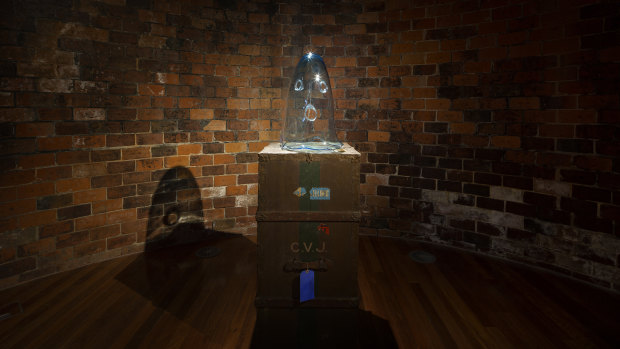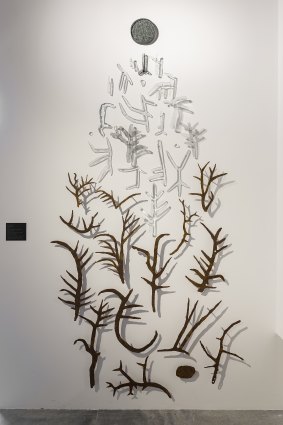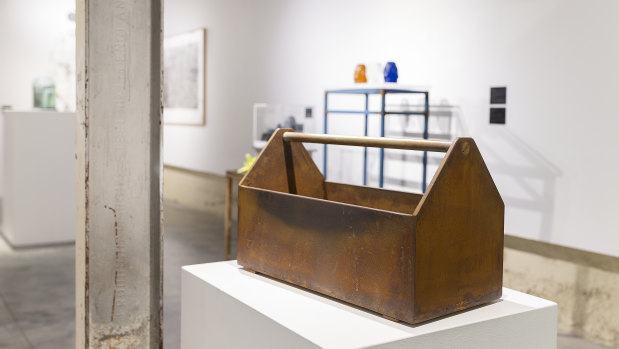This was published 6 years ago
Opinion
A striking collection of creative partnerships in glassmaking
By Kerry-Anne Cousins
Confluence - an exhibition by Annette Blair, G.W. Bot, Paul House, Jeremy Lepisto, Peter Nilsson, Nell, 不NOT, Tom Rowney, Luna Ryan and Nick Stranks. Canberra Glassworks. Until August 12.
The contemporary concept of collaboration between artists is complex. Collaboration and the attribution of artworks to the group was an aspect of creativity taken for granted historically as part of artistic practice in most societies. It is only with the modern development of the concept of individual self-expression that collaboration between artists has retreated to the shadows of artistic practice.

Nell, The ghost who travels will never die (2018), in Confluence at Canberra Glassworks. Courtesy of the artist, Roslyn Oxley9 Gallery Sydney and STATION, Melbourne.
Among craft practitioners and artists who have an object-based practice the notion of artistic collaboration is much more accepted. In fact in contemporary glassmaking studios artists rely on teams of fellow glassmakers for the creation of many glass works.
In the working theme for the exhibition Confluence, it is stated that the exhibition “embraces the collective exploration of glass by pairing experienced glassmakers with those who are less familiar with the medium”. The exhibition brings together a diverse collection of artists. Annette Blair, Jeremy Lepisto, Peter Nilsson, Tom Rowney and Luna Ryan are glassmakers working in collaboration with other artists that include G.W Bot, Nick Stranks, Paul House, Nell and 不NOT - a Sydney-based ceramist.
One of the most striking works that greets the viewer is G. W. Bot’s Portrait III - a large wall assemblage of metal and glass glyphs that are part of the distinctive visual and metaphorical language of the artist. The curved lines of these glyphs dance on the wall drawing the eye upwards towards a central apex represented by an engraved glass medallion.
This medallion appears to be the life force that is the source of growth and life of these vibrant forms. This work relates closely to another other wall sculpture by the artist called Portrait of Gaia shown at the Beaver Galleries in 2016. The forms are similar to Portrait III but are translated into ceramics while the present work uses steel and glass. It is as if the artist is using the same symbols or glyphs but translating them via various media into different visual languages.

G.W. Bot, Portrait III (2018), in Confluence at Canberra Glassworks. Courtesy of the artist and Beaver Galleries.
G. W. Bot was ACT artist-in-residence at the Glassworks in April this year. Her mentor was glass artist Peter Nilsson whose own impressive sculpture The Wolf Hour is in the exhibition.
Ceramic artist 不NOT's exhibition Song Dynasty currently showing at Kronenberg Wright Artists Projects gallery in Sydney includes glass objects that he recently worked on at the Canberra Glassworks. In this exhibition the artist uses the image of the Buddha in his three glass sculptures (mid-Korea, 2018). 不NOT has handcast in glass the Buddha image to counterpoint the widespread mass production and commodification of the Buddha as simply a good luck charm. He has been aided by Luna Ryan and Peter Nilsson.
Nell is an artist from Sydney who works with installation and mixed media. Her schematic version of a symbolic ghost mask with open mouth and sightless eyes is aptly made from translucent glass blown with the assistance of glass artist Annette Blair and team.
This ghost-like symbol in various media such as bronze, ceramics and textiles appears in many of the artist’s previous installations notably her exhibition Magic Objects at the 2017 Adelaide Biennial of Australian Art. In this exhibition the glass ghost "head" sits in a benign fashion on top of a vintage trunk. The title of the work, The Ghost who travels will never die, suggests perhaps the peripatetic nature of ghosts and their propensity to travel with or without luggage.
Jeremy Lepisto and sculptor Nick Stranks have collaborated to create The Fix, 2018. Stranks and Lepisto are interested in industrial sites and the mechanics and tools of industrial construction. The Fix is a large fabricated metal tool box fitted inside with a colourful glass image of an industrial site. Both artists have collaborated to achieve a work that seems to be a perfect amalgamation of both their interests and skills.

Jeremy Lepisto & Nick Stranks, The Fix (2018), in Confluence at Canberra Glassworks. Courtesy of the artists and Beaver Galleries (for Jeremy Lepisto).
Paul House is from the Ngambri/Wallabalooa/Wiradjuri-Erambie peoples. His collection of glass didjeridu were blown by glass artist Tom Rowney. Their long elongated forms and rich colourings make a wonderful rhythmic wall display but, as the accompanying sound track of a welcoming song played by the artist demonstrates, they are not just decorative items but complicated musical instruments.
The invisible links that join all these artists in a collaborative creative network are complex, especially when the glass artists who were mentors are also represented by pieces of their own work. I nearly gave up trying to identify these creative partnerships especially when the labels on the works are hard to decipher. However, what the exhibition does successfully is to draw attention to these creative partnerships. In the end, perhaps all we need to do is acknowledge these partnerships and just enjoy the work that is the result.